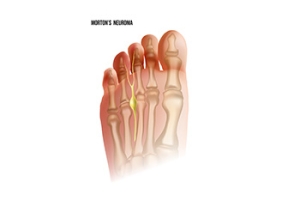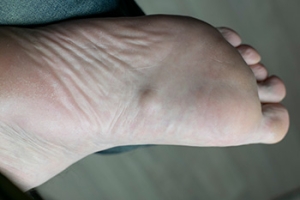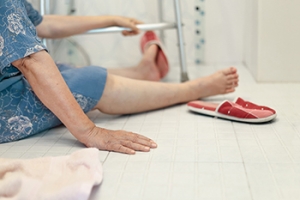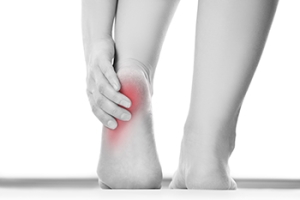Baytown, TX (281) 837-8371

Achilles Tendon Injuries
The Achilles tendon is the largest tendon in the body; it is a tough band of fibrous tissue that stretches from the bones of the heel to the calf muscles. This tendon is what allows us to stand on our toes while running, walking, or jumping, it is common for this tendon to become injured. In severe cases, the Achilles tendon may become partially torn or completely ruptured. However, this tendon is susceptible to injury because of its limited blood supply and the high level of tension it endures.
The people who are more likely to suffer from Achilles tendon injuries are athletes who partake in activities that require them to speed up, slow down, or pivot. Consequently, athletes who engage in running, gymnastics, dance, football, baseball, basketball, or tennis are more likely to suffer from Achilles tendon injuries. Additionally, there are other factors that may make you more prone to this injury. People who wear high heels, have flat feet, tight leg muscles or tendons, or take medicines called glucocorticoids are more likely to have Achilles tendon injuries.
A common symptom of an Achilles tendon injury is pain above the heel that is felt when you stand on your toes. However, if the tendon is ruptured, the pain will be severe, and the area may become swollen and stiff. Other symptoms may be reduced strength in the lower ankle or leg area, and reduced range of motion in the ankle. When the Achilles tendon tears, there is usually a popping sound that occurs along with it. People who have acute tears or ruptures may find walking and standing to be difficult.
If you suspect you have injured your Achilles tendon, you should see your podiatrist to have a physical examination. Your podiatrist will likely conduct a series of tests to diagnose your injury including a “calf-squeeze” test. Calf squeeze tests are performed by first squeezing the calf muscle on the healthy leg. This will pull on the tendon and consequently cause the foot to move. Afterward, the same test will be performed on the injured leg. If the tendon is torn, the foot won’t move because the calf muscle won’t be connected to the foot.
What Is Morton’s Neuroma?
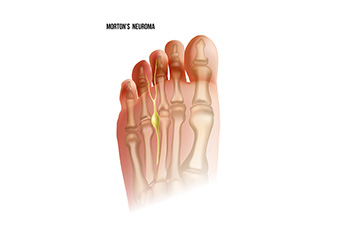
Morton's neuroma is a painful condition affecting the ball of the foot, resulting from a thickening of tissue around a nerve, often between the third and fourth toes. Symptoms include a burning sensation, tingling, or numbness in the affected area, along with the feeling of a small pebble or lump underfoot. Pain may worsen with activity or wearing tight shoes. Treatment options for Morton's neuroma focus on relieving pressure on the affected nerve. This includes wearing shoes with a wider toe box or adding padding to support the arch and alleviate pressure. Avoiding activities that worsen symptoms also helps. Podiatrists may recommend corticosteroid injections to reduce inflammation, or in severe cases, surgical removal of the neuroma. Early intervention ensures effective management, relieving discomfort and restoring foot function. Visiting a podiatrist is suggested for a precise diagnosis and personalized treatment plan.
Morton’s neuroma is a very uncomfortable condition to live with. If you think you have Morton’s neuroma, contact Abeer M. Foteh, DPM of Greater Houston Foot Centers. Our doctor will attend to all of your foot care needs and answer any of your related questions.
Morton’s Neuroma
Morton's neuroma is a painful foot condition that commonly affects the areas between the second and third or third and fourth toe, although other areas of the foot are also susceptible. Morton’s neuroma is caused by an inflamed nerve in the foot that is being squeezed and aggravated by surrounding bones.
What Increases the Chances of Having Morton’s Neuroma?
- Ill-fitting high heels or shoes that add pressure to the toe or foot
- Jogging, running or any sport that involves constant impact to the foot
- Flat feet, bunions, and any other foot deformities
Morton’s neuroma is a very treatable condition. Orthotics and shoe inserts can often be used to alleviate the pain on the forefront of the feet. In more severe cases, corticosteroids can also be prescribed. In order to figure out the best treatment for your neuroma, it’s recommended to seek the care of a podiatrist who can diagnose your condition and provide different treatment options.
If you have any questions, please feel free to contact our office located in Baytown, TX . We offer the newest diagnostic and treatment technologies for all your foot care needs.
What is Morton's Neuroma?
Morton’s neuroma, (also referred to as Morton’s metatarsalgia, Morton’s neuralgia, plantar neuroma or intermetatarsal neuroma) is a condition that is caused when the tissue around one of the nerves between your toes begins to thicken. This thickening can result in pain in the ball of the foot. Fortunately, the condition itself is not cancerous.
Morton’s neuroma affects women more often than men with a ratio of 4:1. It tends to target women between the age of 50 and 60, but it can occur in people of all ages. There are some risk factors that may put you at a slightly higher risk of developing the condition. People who often wear narrow or high-heeled shoes are often found to be linked to Morton’s neuroma. Additionally, activities such as running or jogging can put an enormous amount of pressure on the ligament and cause the nerve to thicken.
There usually aren’t any outward symptoms of this condition. A person who has Morton’s neuroma may feel as if they are standing on a pebble in their shoe. They may also feel a tingling or numbness in the toes as well as a burning pain in the ball of their foot that may radiate to their toes.
In order to properly diagnose you, the doctor will press on your foot to feel for a mass or tender spot. He may also do a series of tests such as x-rays, an ultrasound, or an MRI. X-rays are usually done to rule out any other causes for your foot pain such as a stress fracture. Ultrasounds are used to reveal soft tissue abnormalities that may exist, such as neuromas. Your podiatrist may want to use an MRI in order to visualize your soft tissues.
There are three main options for treatment of Morton’s neuroma: Injections, decompression surgery, and removal of the nerve. Injections of steroids into the painful area have been proven to help those with Morton’s neuroma. Decompression surgery has been shown to relieve pressure on the affected nerve by cutting nearby structures such as the ligaments in the foot. Another treatment option would be to surgically remove the growth to provide pain relief.
If you suspect that you have Morton’s neuroma you should make an appointment with your podiatrist right away. You shouldn’t ignore any foot pain that lasts longer than a few days, especially if the pain does not improve.
Definition and Phases of Plantar Fibromatosis
 Plantar fibromatosis is a benign condition characterized by the growth of fibrous nodules in the plantar fascia, a thick band of tissue located along the bottom of the foot. These nodules typically develop in the arch and can vary in size, The condition progresses through three phases. In the early phase, small, painless nodules form, and in the intermediate phase, these nodules grow larger and may cause discomfort. In the late phase, the nodules become more fibrous and can lead to significant pain and difficulty walking. Symptoms include firm lumps in the arch of the foot, pain when standing or walking, and stiffness in the affected area. If you have lumps or nodules on the bottom of your foot, it is suggested that you make an appointment with a podiatrist who can discuss effective treatment options with you.
Plantar fibromatosis is a benign condition characterized by the growth of fibrous nodules in the plantar fascia, a thick band of tissue located along the bottom of the foot. These nodules typically develop in the arch and can vary in size, The condition progresses through three phases. In the early phase, small, painless nodules form, and in the intermediate phase, these nodules grow larger and may cause discomfort. In the late phase, the nodules become more fibrous and can lead to significant pain and difficulty walking. Symptoms include firm lumps in the arch of the foot, pain when standing or walking, and stiffness in the affected area. If you have lumps or nodules on the bottom of your foot, it is suggested that you make an appointment with a podiatrist who can discuss effective treatment options with you.
A plantar fibroma may disrupt your daily activities. If you have any concerns, contact Abeer M. Foteh, DPM of Greater Houston Foot Centers. Our doctor can provide the care you need to keep you pain-free and on your feet.
Plantar Fibroma
A plantar fibroma is a fibrous knot in the arch of the foot. It is embedded in the plantar fascia which is a band of tissue that extends from the heel to the toes along the bottom of the foot. There can be multiple plantar fibromas in the feet at the same time. There are no known causes for this condition. If you have a plantar fibroma, there will be a bump in the arch of your foot that cannot be missed. Any associated pain is most often due to a shoe rubbing against the nodule. Non-surgical options, such as steroid injections, physical therapy, and orthotics should be tried first. Surgery is a last resort and is the only thing that will remove a plantar fibroma entirely. Consult with a podiatrist for a proper diagnosis and to determine the treatment regimen that is right for you.
What Causes a Plantar Fibroma?
While there are no specific causes identified, a plantar fibroma can possibly come from genetic predisposition or the formation of scar tissue that forms from healing the tears in the plantar fascia.
What Are the Symptoms of a Plantar Fibroma?
There will be a noticeable lump in the arch of the foot that may or may not cause pain. If pain is felt, it is typically because a shoe is rubbing up against the lump or when walking or standing barefoot.
Treatment and Prevention
A plantar fibroma will not disappear without treatment, but it can get smaller and be a non-issue. If pain persists, a podiatrist examines the foot and when the arch of the foot is pressed, pain can be felt down to the toes. An MRI or biopsy might be performed to help diagnose or evaluate the plantar fibroma. The following non-surgical options are generally enough to reduce the size and pain of these nodules:
- Steroid injections
- Orthotics
- Physical therapy to help apply anti-inflammatory creams on the bump
Surgery is considered if the mass increases in size and the patient continues to feel pain after non-surgical methods are tried.
If you have any questions please feel free to contact our office located in Baytown, TX . We offer the newest diagnostic tools and technology to treat your foot and ankle needs.
Plantar Fibroma
A plantar fibroma is a knot in the arch of the foot. It can cause pain when repeated pressure is applied by walking barefoot or wearing tight shoes. While plantar fibromas can appear in anyone, men who are middle-aged or older are said to be more susceptible. The main symptom of a plantar fibroma is a firm lump on the arch of the foot. If there is pain, it can be intensified by putting pressure on the nodule. The lump can stay one size or grow larger. You may have one or more fibromas in the feet and there tends to be a high incidence of recurring plantar fibromas. Generally, a plantar fibroma can be treated without surgery. Treatment might include steroid injections to help shrink the lump, orthotics to help redistribute weight away from the nodule, plantar fascia stretching, or physical therapy to help use anti-inflammatory medication on the lump. If a lump grows larger or more painful, a podiatrist can be consulted to confirm the diagnosis. The doctor will palpate the lump and this may cause pain that can be felt all the way to the toes. An X-ray, MRI, or biopsy might be done if further evaluation is necessary. A lump in the arch of the foot might be something other than a plantar fibroma, such as cysts, nerve or fatty tumors, swollen tendons, or an infection in the foot. It is important to see a podiatrist for proper diagnosis and treatment of plantar fibromas.
Preventing Falls in Older People
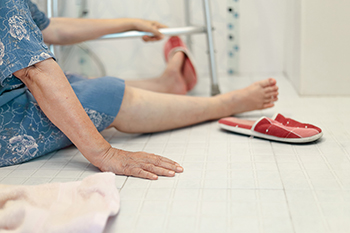 Falls are a significant concern for older adults, often resulting in serious injuries and decreased independence. Factors contributing to falls can include poor balance, muscle weakness, and foot problems such as neuropathy, arthritis, or wearing improperly fitted footwear. As we age, changes in vision and the side effects of medications can also increase the risk of falling. Preventing falls requires a proactive approach focusing on foot health. Older adults should regularly check their feet for any abnormalities and wear shoes that provide adequate support and have non-slip soles. Keeping floors clear of clutter, installing grab bars in bathrooms, and ensuring adequate lighting throughout the home can also help reduce fall risks. Engaging in regular physical activity, such as balance exercises and strength training, can improve stability and coordination. Additionally, reviewing medications with a healthcare provider can help identify those that may affect balance. If you are elderly and want to prevent the risk of falls and get help for any foot problems that might play a role, it is suggested that you visit a podiatrist regularly to maintain good foot health.
Falls are a significant concern for older adults, often resulting in serious injuries and decreased independence. Factors contributing to falls can include poor balance, muscle weakness, and foot problems such as neuropathy, arthritis, or wearing improperly fitted footwear. As we age, changes in vision and the side effects of medications can also increase the risk of falling. Preventing falls requires a proactive approach focusing on foot health. Older adults should regularly check their feet for any abnormalities and wear shoes that provide adequate support and have non-slip soles. Keeping floors clear of clutter, installing grab bars in bathrooms, and ensuring adequate lighting throughout the home can also help reduce fall risks. Engaging in regular physical activity, such as balance exercises and strength training, can improve stability and coordination. Additionally, reviewing medications with a healthcare provider can help identify those that may affect balance. If you are elderly and want to prevent the risk of falls and get help for any foot problems that might play a role, it is suggested that you visit a podiatrist regularly to maintain good foot health.
Preventing falls among the elderly is very important. If you are older and have fallen or fear that you are prone to falling, consult with Abeer M. Foteh, DPM from Greater Houston Foot Centers. Our doctor will assess your condition and provide you with quality advice and care.
Every 11 seconds, an elderly American is being treated in an emergency room for a fall related injury. Falls are the leading cause of head and hip injuries for those 65 and older. Due to decreases in strength, balance, senses, and lack of awareness, elderly persons are very susceptible to falling. Thankfully, there are a number of things older persons can do to prevent falls.
How to Prevent Falls
Some effective methods that older persons can do to prevent falls include:
- Enrolling in strength and balance exercise program to increase balance and strength
- Periodically having your sight and hearing checked
- Discuss any medications you have with a doctor to see if it increases the risk of falling
- Clearing the house of falling hazards and installing devices like grab bars and railings
- Utilizing a walker or cane
- Wearing shoes that provide good support and cushioning
- Talking to family members about falling and increasing awareness
Falling can be a traumatic and embarrassing experience for elderly persons; this can make them less willing to leave the house, and less willing to talk to someone about their fears of falling. Doing such things, however, will increase the likelihood of tripping or losing one’s balance. Knowing the causes of falling and how to prevent them is the best way to mitigate the risk of serious injury.
If you have any questions, please feel free to contact our office located in Baytown, TX . We offer the newest diagnostic and treatment technologies for all your foot care needs.
Falls Prevention
Elderly Americans are very susceptible to falls as they get older. Everyone experiences decreases in flexibility, balance, strength, and the senses as they age. This correlates to some eye-opening statistics. 1 in 4 Americans aged 65 and older fall each year. An elderly American is being treated for a fall in an emergency room every 11 seconds. In light of these striking statistics, one can see the importance of taking steps to prevent falls.
Finding an exercise program for the elderly is an excellent way to reduce the likelihood of falls. Look for an exercise program that improves strength and balance. Elderly people who live a more sedentary lifestyle, with little physical activity, are at an increased risk of falling. Wearing well-fitted footwear that provides good foot support and cushion will help prevent falls from poorly fitted shoes. Talking to a podiatrist about your susceptibility to falls and about inspecting your prescriptions will help to avoid any medication that could make falls more likely. Due to a decline in the senses among the elderly, having your eyes and hearing checked is recommended.
Around half of all falls occur in the household. Removing tripping hazards in the home and making it more accommodating to older persons can significantly reduce falls. Some notable household changes include increasing lighting around the house, installing grab bars in the shower and bathroom, and making sure the floor is clear of clutter. Other smart options include installing a shower chair, using rubber-bottomed rugs, and placing railings on both sides of stairwells.
Finally, discuss with a doctor and your family about your fear of falling. This will help to increase awareness among the population on the need for fall prevention. A lack of awareness on the matter, and a downplaying of importance are what increase the risks of falling. Following these tips can help to reduce the risk for yourself and your loved ones.
Quality of Life and Heel Pain
 Plantar heel pain, often caused by plantar fasciitis, can significantly impact quality of life. This condition occurs when the thick band of tissue running along the bottom of the foot becomes inflamed, typically due to overuse or strain. The resulting pain can make walking and standing difficult, limiting daily activities and reducing overall mobility. Factors such as wearing poor footwear, obesity, and prolonged standing contribute to this issue. To alleviate plantar heel pain, several measures can be taken. Wearing supportive shoes with proper arch support and cushioning is vital. Stretching exercises for the calf and foot can help relieve tension in the plantar fascia. Taking pain relievers can reduce inflammation and discomfort. In severe cases, custom orthotics may be necessary. If you have persistent heel pain, it is suggested that you schedule an appointment with a podiatrist for effective treatment and long-term relief.
Plantar heel pain, often caused by plantar fasciitis, can significantly impact quality of life. This condition occurs when the thick band of tissue running along the bottom of the foot becomes inflamed, typically due to overuse or strain. The resulting pain can make walking and standing difficult, limiting daily activities and reducing overall mobility. Factors such as wearing poor footwear, obesity, and prolonged standing contribute to this issue. To alleviate plantar heel pain, several measures can be taken. Wearing supportive shoes with proper arch support and cushioning is vital. Stretching exercises for the calf and foot can help relieve tension in the plantar fascia. Taking pain relievers can reduce inflammation and discomfort. In severe cases, custom orthotics may be necessary. If you have persistent heel pain, it is suggested that you schedule an appointment with a podiatrist for effective treatment and long-term relief.
Many people suffer from bouts of heel pain. For more information, contact Abeer M. Foteh, DPM of Greater Houston Foot Centers. Our doctor can provide the care you need to keep you pain-free and on your feet.
Causes of Heel Pain
Heel pain is often associated with plantar fasciitis. The plantar fascia is a band of tissues that extends along the bottom of the foot. A rip or tear in this ligament can cause inflammation of the tissue.
Achilles tendonitis is another cause of heel pain. Inflammation of the Achilles tendon will cause pain from fractures and muscle tearing. Lack of flexibility is also another symptom.
Heel spurs are another cause of pain. When the tissues of the plantar fascia undergo a great deal of stress, it can lead to ligament separation from the heel bone, causing heel spurs.
Why Might Heel Pain Occur?
- Wearing ill-fitting shoes
- Wearing non-supportive shoes
- Weight change
- Excessive running
Treatments
Heel pain should be treated as soon as possible for immediate results. Keeping your feet in a stress-free environment will help. If you suffer from Achilles tendonitis or plantar fasciitis, applying ice will reduce the swelling. Stretching before an exercise like running will help the muscles. Using all these tips will help make heel pain a condition of the past.
If you have any questions please contact our office located in Baytown, TX . We offer the newest diagnostic and treatment technologies for all your foot and ankle needs.
Heel Pain
Heel pain can be difficult to deal with, especially if you do not know what the underlying cause is. If you ignore your heel pain, the pain can magnify and potentially develop into a chronic condition. Depending on the location of your heel pain, you have developed a specific condition.
One condition is plantar fasciitis. Plantar fasciitis is caused by the inflammation of the plantar fascia, or the band of tissue that connects the heel bone to the base of the toes. The pain from this condition is initially mild but can intensify as more steps are taken when you wake up in the morning. To treat this condition, medication will likely be necessary. Plantar fasciitis is often associated with heel spurs; both require rest and special stretching exercises.
There are various options your podiatrist may suggest for heel pain. Treatment options for heel pain typically include non-steroidal anti-inflammatory drugs (NSAIDS), which may reduce swelling and pain. Other options are physical therapy, athletic taping, and orthotics. In severe cases of heel pain, surgery may be required.
Preventing heel pain is possible. If you are looking to prevent heel pain from developing in the future, be sure to wear shoes that fit you properly and do not have worn down heels or soles. Be sure to warm up properly before participating in strenuous activities or sports that place a lot of a stress on the heels. If you are experiencing any form of heel pain, speak with your podiatrist to determine the underlying cause and receive the treatment you need.




